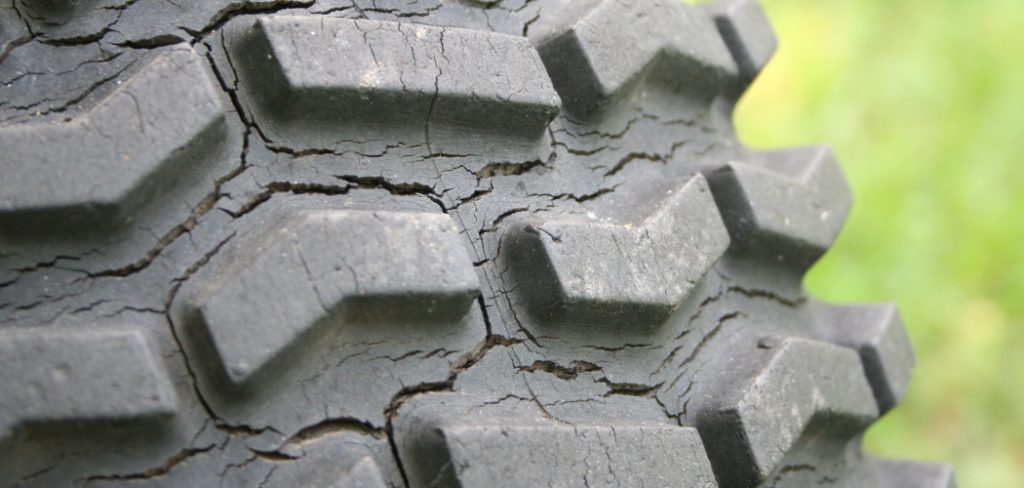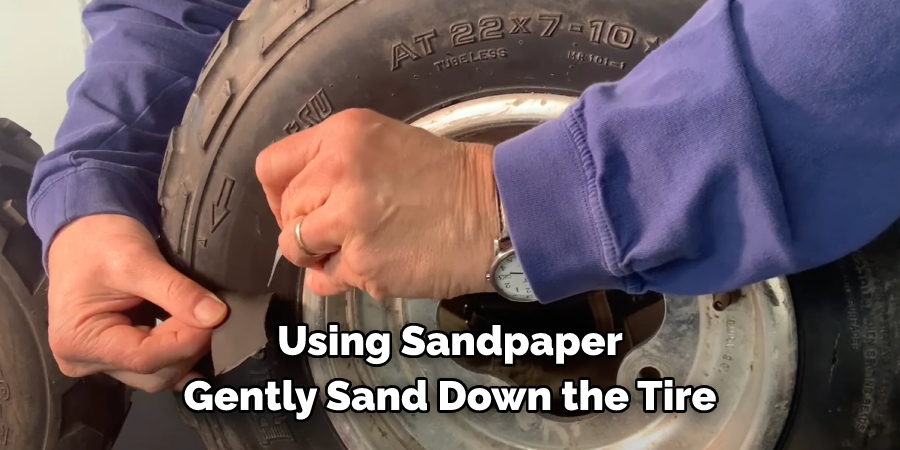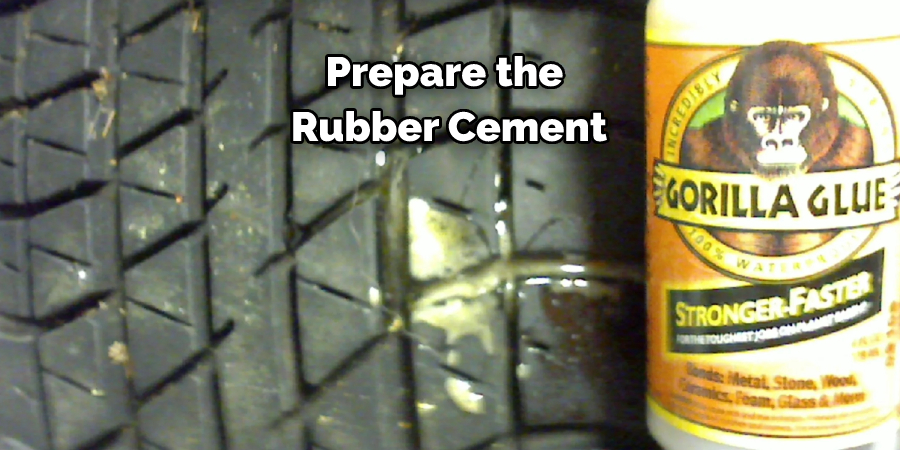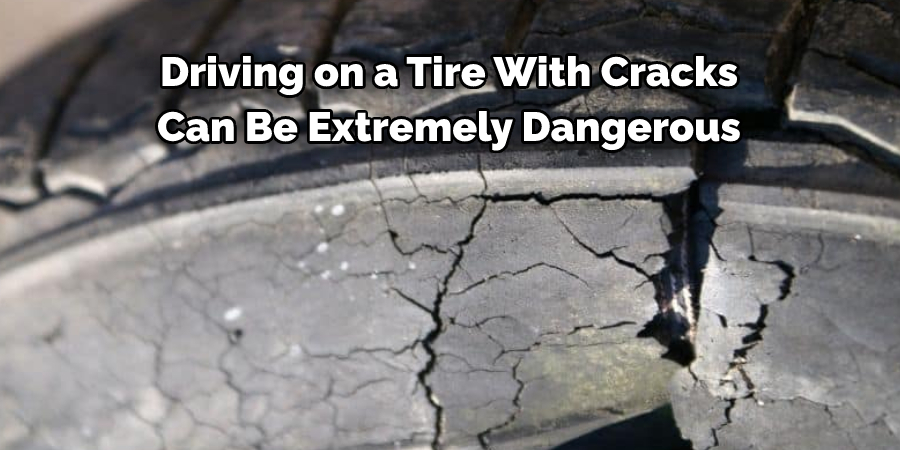Are your tires starting to look a bit worse for wear lately? Do you notice tiny cracks appearing along the surface? Whether they’re due to sunlight, temperature changes, or road hazards, tire cracks are more than just an eyesore — they can lead to serious safety concerns if left unchecked. If you want to ensure continued safe and reliable driving in your vehicle, it’s important that you address these issues quickly and correctly.

In this blog post, we’ll discuss how to fix tire cracks so that you can be back on the road (safely!) as soon as possible.
Tools and Materials You Will Need to Fix Tire Cracks
- Tire patch kit
- Clean rags or towels
- Water
- Sandpaper
- Tire sealant
Step by Step Guidelines on How to Fix Tire Cracks
Step 1: Inspect Your Tires for Cracks
The first step to fixing tire cracks is to locate the damaged area. It’s important that you identify all the cracks and damage so that you can properly patch them up. Carefully inspect the tires for signs of distress such as bulges, cuts, or cracks. If needed, use a flashlight to better illuminate the area and search for any missed damage.
Step 2: Clean the Area Around the Tire Crack
Once you’ve identified the damaged area, it’s time to clean the area around the tire crack. Use a rag or towel to remove any excess dirt and debris before you start patching up your tires. This will help ensure that the patch adheres properly and prevents any further damage from occurring.
Step 3: Sand Down the Tire Crack
Using sandpaper, gently sand down the tire crack to create a rough surface. This will help the patch adhere properly and ensure that it doesn’t come loose after you’ve repaired the damage. Once you’ve finished, wipe away any remaining debris with a clean rag or towel.

Step 4: Apply Tire Patch
Now it’s time to apply the tire patch. Open up your tire patch kit and follow the instructions carefully. Make sure that you fully adhere the patch to the damaged area so that it creates a waterproof seal. This will help prevent any further damage from occurring and keep your tires in good condition for longer.
Step 5: Apply Tire Sealant
Once you’ve applied the tire patch, it’s important to finish off by applying a tire sealant. This will help protect your tires from further damage and ensure that the patched area is fully sealed. Simply follow the instruction manual provided with your tire sealant and apply it as needed.
And there you have it! Through these simple steps, you can repair any tire cracks that may be affecting your tires. Remember to always take all necessary safety precautions when handling repairs and patching up tires. If in doubt, don’t hesitate to consult a professional for help.
Additional Tips and Tricks to Fix Tire Cracks
1. Use a protective sealant to coat the outside and inside of your tire’s sidewall. This will form a barrier between the inner steel belt and any further damage from road debris. It will also help prevent additional cracking due to oxidation or temperature fluctuations.

2. Inspect your tires regularly for signs of wear and tear, including cracking. Make sure to inflate your tires properly and adjust the air pressure when needed.
3. When purchasing new tires, look for those with a higher rubber content, as these will generally have greater durability and resistance to wear.
4. If you frequently drive on rough roads or highways, be sure to inspect your rims for signs of damage. If your rims are cracked or bent, it could put undue stress on the sidewall of your tires, leading to additional cracking.
5. Make sure to rotate your tires every 3,000-4,000 miles to ensure even wear and tear across all four tires. Unevenly worn tires can cause increased stress on the sidewalls, leading to additional cracking.
6. Consider investing in a tire pressure monitoring system (TPMS) for your vehicle. This will alert you if there is an issue with air pressure, allowing you to make adjustments before any further damage can occur.
7. If you notice a crack in your tire, take it to a professional as soon as possible. They will be able to evaluate the damage and recommend the best course of action for repairing or replacing your tire.
Following these tips can help you extend the life of your tires and prevent any further cracking from occurring. Remember to always inspect your tires regularly and take note of any changes or irregularities. With proper care and attention, you can ensure that your tires are safe and reliable for many years to come!
Things You Should Consider While Fixing Tire Cracks
1. Choose the right material. Rubber cement and patches are available in hardware stores to fix tire cracks. It is important to choose a patch that is compatible with the type of material used in your tires, such as natural rubber or synthetic rubber.
2. Clean the surface area. Before applying any materials, it is essential to clean the surface area of the tire. This will get rid of any dirt, debris, and oils that could prevent the patch from properly adhering to the surface.
3. Prepare the rubber cement. Read and follow all instructions on the container of rubber cement before using it. Make sure it is mixed properly according to package directions for best results.

4. Apply the rubber cement and patch. Using a brush, apply a thin layer of rubber cement over the crack and around its edges. Then place the patch over the crack and press it down with even pressure to ensure it is properly adhered to the surface area.
5. Allow for drying time. Depending on the type of rubber cement used, drying times can vary. Always follow package instructions for best results.
6. Inspect the area. After drying time is complete, inspect the area to make sure there are no air bubbles or other irregularities on the patch’s surface. If necessary, adjust as needed before moving on to the next step.
7. Apply tire sealant. To ensure the patch is adequately sealed and to protect against future cracking, apply a coat of tire sealant over the entire patch area. Allow it to dry before using the tire as normal.
By following these considerations and instructions, you can successfully fix tire cracks and help ensure your tires are in safe working condition.
Frequently Asked Questions
Can a Tire With Cracks Be Fixed?
In some cases, you may be able to patch or plug the crack in your tire and extend its life. However, this is only a temporary fix and it’s important to replace the tire as soon as possible. If the crack is more than 1/4 inch deep, the tire should be replaced right away.
What Kind of Tires Are Most Susceptible to Cracks?
Tires that are older, worn down, and not properly maintained are more susceptible to cracking. Also, tires that have been stored in extreme temperatures (hot or cold) may be weakened and prone to cracking.
How Can I Prevent Tire Cracks?
It’s important to regularly inspect your tires for any signs of wear and tear. Make sure they are properly inflated and rotated according to the manufacturer’s recommendations. Additionally, if you are storing your tires in extreme temperatures, make sure they are not exposed to direct sunlight or cold weather.
What Are the Signs That a Tire Might Be Weak or Worn Out?
Look for signs of wear such as bulging, cracking, punctures, and bald spots. If you notice any of these issues, it’s important to have your tire inspected by a professional and replaced if necessary. Additionally, if your tire is more than 6 years old or has been driven over 20,000 miles, it’s time to replace it!
What Are the Dangers of Driving on a Tire With Cracks?
Driving on a tire with cracks can be extremely dangerous. The tire may not hold air and it could also cause handling problems or poor braking performance. Additionally, if the crack is deep enough, it can lead to complete tire failure which can be catastrophic. It’s always important to replace any cracked tires as soon as possible.

Conclusion
Tire cracks can be fixed with the right materials and a little DIY know-how. With some preparation and guidance, you can cut your repair time substantially, leading to an ultimately cheaper fix in the long run. As with any repair job, take the necessary precautions for your safety and always do what is within your comfort level.
If you’re unsure about a certain step of the process of how to fix tire cracks, reach out to a professional or local auto-part shop for advice or assistance. It’s always better to make sure the repairs are done correctly than to scrimp on taking adequate precautions. We hope this post has given you a one-stop resource for all of the cracked tire questions that will keep you safe and comfortable on the roads as we journey through our lives.
